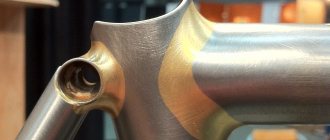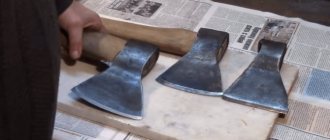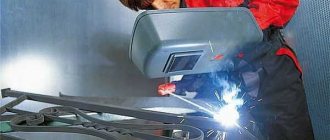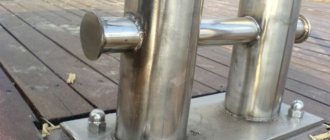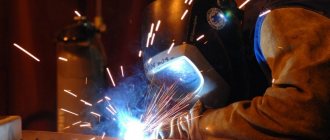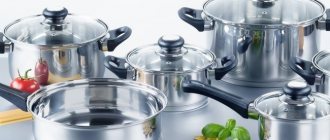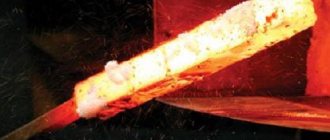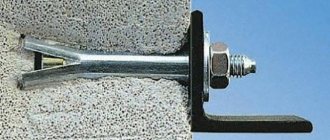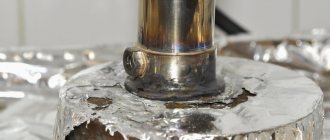Despite the fact that such a technological procedure as hardening stainless steel products leads to a decrease in their ductility and flexibility, the use of this heat treatment method makes it possible to give them exceptional hardness. Modern hardening technologies and their correct selection provide high quality steel, in which the proportions of strength, ductility and toughness are optimally maintained. Products treated in this way have significantly improved performance characteristics.
Hardening of steel in an induction channel installation
Differences in hardening between stainless steel and carbon steel
All alloying elements included in the composition of corrosion-resistant steel are conventionally divided into two groups:
- The first is elements that increase the temperature of the polymorphic transformation. These include copper, vanadium, tungsten, molybdenum, titanium, niobium. For stainless steel containing such additives, an increase in the quenching temperature is required.
- The second is elements that lower the critical temperature at which a change in the crystal lattice occurs. These are manganese and nickel. With steels containing manganese, it is not recommended to allow overheating, since this element provokes the growth of austenitic grains.
Attention! Carbide-forming elements - chromium, molybdenum, tungsten, vanadium, titanium - suppress the growth of austenite grains. Therefore, steels containing them are not subject to overheating; they are usually heated to higher temperatures compared to carbon steels.
In relation to unalloyed carbon stainless steels require:
- due to worse thermal conductivity - longer exposure for high-quality heating;
- slower cooling, for which oil baths are usually used.
The main stages of the heating process
To harden stainless steel, it is advisable to know its exact grade, or at least which type of carbon it belongs to (more or less than 0.4%). This is very important, because in order to properly harden the product, after the hardening itself it must also be released.
The brand of factory stainless steel can be found out from the seller of the workpiece, who can also advise on how best to harden it. If some old thing is used as the starting material, then the Internet will come to the rescue with tables of products and grades of steel from which they are made.
In general, the full heat treatment cycle of a stainless steel part includes the following steps:
- Preparation of equipment, tools and materials. This includes checking the fuel (coal or gas), which should be sufficient for the entire heating cycle. After all, in order to qualitatively harden stainless steel, it should be heated smoothly and without interruptions.
- Warming up the forge or stove. If gas-flame heating is used to harden the part, a stainless steel workpiece is installed and the gas burner is turned on.
- Placement of the workpiece. Often it is necessary to harden only some part of the future product, so it should be placed so that this part is in the maximum temperature zone.
- Heating to the required temperature. The product is kept in a high-temperature zone, controlling its heating by color. In order to harden chromium stainless steel, it must be heated to 1050 ºC. This corresponds to a color that is defined in the tables as orange or dark yellow.
- Cooling. After the heated metal has acquired the required color, the part is cooled by immersing it in a container with mineral oil. It can ignite, so keep a piece of thick cloth next to the container.
- Cleaning. After cooling in oil, the stainless steel should be thoroughly cleaned. In case of severe contamination, a solvent can be used.
- Vacation. To harden your part “according to science”, after heating and cooling it should be released. For steels with a carbon content of 0.4% or more, the tempering temperature is 200÷250 ºC (see table below), so it is enough to place them in a regular kitchen oven for a couple of hours. With a lower carbon content, the tempering temperature is much higher, up to 700÷750 ºC, and it is carried out with gradual cooling in air or in dry sand.
Particular attention should be paid to protective clothing and everything necessary to comply with fire safety, especially during the process of cooling the part in oil.
How to harden low-carbon stainless steel with pre-carburization?
Stainless steel grades with low carbon content (0.1-0.3%) are not suitable for hardening. To harden rolled products and products made from such alloys, saturation of the surface layer with carbon (cementation) is often used, followed by hardening and low tempering. The purpose of this treatment is to obtain a hard, wear-resistant surface, which is achieved by enriching the top layer with carbon to a concentration of 0.8-1.2%.
The results that carburization in combination with hardening and tempering can achieve:
- the core of the product, not saturated with carbon, remains viscous even after hardening;
- wear resistance increases;
- endurance limit increases.
Hard carburization of stainless steels is carried out by placing the product in boxes with a carburizer, which uses crushed graphite or other material, followed by hardening and low tempering. Solid carburizer is used at home or in small-scale production. For mass production of metal products, carburization in a gas environment is in demand. Options are liquid and vacuum cementation.
Main nuances when hardening stainless steel
Basics of stainless steel hardening: choice of temperature conditions, main stages and important features. Necessary equipment, materials and tools. How to harden stainless steel at home.
Hardening of stainless steel differs from hardening of non-alloy steels in a higher temperature, holding time, and the rate of heating and cooling. This is because alloying components change the critical (austenitic) heating point and reduce the thermal conductivity of the metal.
In order to harden corrosion-resistant steel (stainless steel), it must be heated to a temperature of at least a thousand degrees, and then cooled in an oil environment. It is known that for successful hardening of ordinary steel it is necessary that the carbon content in it be at least 0.4%.
This does not apply to stainless steel, since alloying additives make it possible to harden it at a lower carbon content. Among craftsmen who make knives and cutting tools, the most popular is domestic stainless steel grade 40X13 (and its analogues), which contains 0.35÷0.45% carbon and about 12÷14% chromium.
It is affordable, easy to process, and can be hardened in almost any environment. In order to harden their stainless steel products, home craftsmen, as a rule, use homemade equipment, improvised means and inexpensive materials, and select temperature conditions “by eye”.
How to harden stainless steel with intermediate saturation of the surface layer with carbon?
- The carburization process takes place at temperatures of 910-950°C, and if it is necessary to accelerate it, at 1000-1050°C.
- After carburization, which is an intermediate process, hardening is necessary, which strengthens the carburized layer and corrects the overheating structure. To correct structural defects and reduce metal warping that occurs due to prolonged exposure at high carburization temperatures, double hardening is used.
The mandatory final operation is low tempering, carried out at temperatures of 160-180°C, due to which the quenched martensite in the surface layer is transformed into tempered martensite.
Source
What is stainless steel
Stainless steel
– These are iron-based alloys with various impurities. The most common alloying additives are carbon, chromium, nickel, titanium, and niobium. Each of the elements imparts new physical and mechanical properties to the alloy, thereby increasing its strength or increasing its ductility. The main advantage of stainless steel is its resistance to corrosion; it owes this property to chromium, which is present in every stainless alloy. A sufficient amount of this element ensures the anti-corrosion properties of the metal.
The presence of nickel gives the alloy many important qualities: ductility, heat-resistant properties, improves the quality of weldability, and reduces the rate of corrosion. With the acquisition of anti-corrosion properties, stainless steel is not inferior in strength to ordinary steel. Stainless steel retains all the valuable qualities of metals: it is both strong and ductile, and lends itself well to processing: cutting, welding, rolling, stretching, bending. Due to its good performance, stainless steel is used for the manufacture of stainless steel products. All grades of stainless steel are manufactured in accordance with GOST 5632-2014.
Technology for home heating of stainless steel
In fact, hardening a workpiece for a future stainless steel product (knife or tool) is not so difficult. To do this, just understand the temperature conditions and follow all the recommendations. However, heat treatment is a high-risk production.
Therefore, to harden stainless steel at home, you first need to decide on the organization of the work site. In order to qualitatively harden stainless steel and at the same time not cause damage to the room and your own health, you must comply with some conditions.
Firstly, all heating sources must be safe, stable and reliably protected from accidental contact with heated elements. Secondly, quenching liquids must be in secure containers and located away from heating equipment.
If you need to harden a long stainless steel product, you should use containers that allow you to completely immerse it in the hardening liquid at one time. Thirdly, the work site must be spacious enough for movement and ventilated from smoke and gases.
Temperature selection
For stainless steel, this is the point of stable formation of austenite - a solid solution of carbon in iron. To harden stainless steel means to quickly cool such a structure, preventing its atoms from returning to their original (before heating) state.
Therefore, both the heating temperature and the holding time in the heated state, as well as the cooling rate, which for stainless steel should not be too high, are important. Slowing down the cooling process is achieved by cooling the product in oil, which has low thermal conductivity.
If you harden a part in water, it will be very fragile and will almost certainly be covered with microcracks. Advanced folk craftsmen measure the heating temperature using temperature sensors, and in everyday conditions it is determined by the color of the metal. The exact temperature conditions for each grade of stainless steel can be found in technological reference books.
Heating process step by step
To harden a small stainless steel product at home without using furnaces or forges, just heat it with a burner or on a gas stove, determining the temperature by the color of the metal. After this, it is cooled in oil, cleaned and tempered, for which a gas stove oven is quite suitable.
If you need to harden a stainless steel workpiece in an isothermal mode (in production this is done by maintaining heating in molten salt), then after heating it on gas, you can place it in dry sand. In this case, the cooling temperature is controlled by the color of the tarnish.
To properly harden stainless steel, you need to know its brand. There is often a statement that the type of stainless steel can be determined quite accurately by the color of the sparks on the grindstone. What do you think about this? Please share your opinion in the comments.
Source
Decoding steel markings
Alloy steels are those into which special chemical elements are introduced: nickel, chromium, cobalt, titanium, tungsten. Their addition to the steel composition serves to influence the structure of the metal and obtain improved properties. The marking of steels depends on the chemical composition. At the beginning, numbers are indicated indicating the carbon content in hundredths of a percent (GOST 4543-2016). Next are the letters that indicate alloying elements. In the names of steel and alloy grades, chemical elements are designated by the following letters:
- A (at the beginning of the mark) - sulfur;
- A (in the middle of the mark) - nitrogen;
- B - niobium;
- B - tungsten;
- G - manganese;
- D - copper;
- E - selenium;
- K - cobalt;
- M - molybdenum;
- N - nickel;
- P - phosphorus;
- P - boron;
- C—silicon;
- T - titanium;
- F - vanadium;
- X - chromium;
- C—zirconium;
- Yu - aluminum;
- h - REM (rare earth metals: lanthanum, praseodymium, cerium, etc.).
Classification of stainless steel grades
The classification of stainless steel differs in different countries, but there are general similar principles by which stainless steel is divided into several types:
Austenitic stainless steel
The austenitic group includes alloys with a high content of chromium and nickel. Austenitic stainless steel is characterized by increased strength and flexibility, is easily amenable to various types of processing and has increased anti-corrosion properties. This type of stainless steel has found its application in industry. Austenitic steel is a non-magnetic metal.
This group is divided into several types of stainless steel:
A1
– steel containing a large amount of sulfur. Due to this, it has the lowest corrosion resistance.
A2
– the most commonly used grade of stainless steel. Easy to weld, does not lose its properties at low temperatures. Among the disadvantages, it can be noted that this steel does not withstand an aggressive acidic environment.
A3
– improved version of A2 steel. Components have been added to the composition that allow stainless steel not to change its properties at high temperatures and in an acidic environment.
A4
– an alloy with the addition of molybdenum (up to 3%). Mainly used in shipbuilding, as the steel is characterized by a high level of resistance in an acidic environment.
A5
– has almost the same properties as A4. They differ from each other only in the ratio of additives in the alloy composition. This type of stainless steel is used for increased resistance to ultra-high temperatures.
Ferritic stainless steel
In the group of ferritic alloys, the chromium content in the composition is increased, it reaches 20%. Because of this, this type of stainless steel is sometimes called “chromium.” The chemical composition of ferritic stainless steel is resistant to aggressive external environments. Ferritic steel grades have magnetic properties. Ferritic stainless steel is widely used in industry as it is relatively cheap.
Martensitic stainless steel
A special type of stainless steels are martensitic alloys. They are characterized by high strength and wear resistance. Martensitic steel grades contain a minimum amount of harmful substances that are not released when heated. Martensitic alloys include heat-resistant corrosion steel.
Duplex stainless steel
The last type of stainless steel that combines the properties of all other groups is duplex alloys. Innovative steels are developed individually, depending on the customer’s needs.
The types of stainless steel are not limited to the above, since any percentage change in the substances in the composition can lead to the creation of a new type of stainless steel.
What you need for work
If you need to qualitatively harden a long product, then it is better to use the first two options, since in this case the entire volume of the stainless steel is heated at the same time. With gas-flame hardening, heating occurs by moving a narrow heating zone along the product, so the quality may be lower.
But this method is well suited for one-time work. If it is necessary to harden a large number of stainless steel products or such work is supposed to be performed constantly, then it is better to spend some time and effort on making a small chamber furnace (see photo below) or build an improvised forge.
With the help of such a stove, you can heat up to the desired temperature and harden products not only from stainless steel, but also from heat-resistant steels. ShB type fireclay bricks are used as a refractory material here, and heating is carried out by a gas burner flame directed into the inner chamber.
If you don’t want to make stationary thermal equipment, but there is a need to harden a stainless steel part up to 30÷40 cm long, then you can get by with a simple forge bent from a sheet of steel (see photo below).
The fuel used here is regular barbecue charcoal, and the air is pressurized from below using a hair dryer.
In order to qualitatively harden a stainless steel workpiece with slow cooling, you will need several liters of mineral oil in a tin container. Any automotive or industrial oil will do, even motor oil.
The main tool for heat treatment is regular or clamping pliers. In addition, you will need thick, non-flammable gloves or mittens and the same overalls or a blacksmith’s apron. All work should be performed either outdoors or in a well-ventilated area, away from flammable materials.
Application of stainless steel
Previously, stainless steel was used only in industrial production, but over time, stainless steel is widely used in various areas of our lives.
The main areas include:
- Mechanical engineering;
- Chemical industry;
- Energy;
- Pulp and paper industry;
- Food industry;
- Medicine;
- Aerospace sector;
- Construction.
Food grade stainless steel
In the food industry, stainless steel is used - an alloy with a low amount of chemical additives, since the equipment is not exposed to temperature changes and aggressive substances. Frost-resistant materials are used for refrigeration and freezing units.
Stainless steel grades for the food industry AISI 304, AISI 304L, AISI 316, AISI 316L, AISI 316Ti, AISI 321, AISI 430 are widely used.
Stainless medical steel
Stainless steel plays a huge role in medicine. Medical instruments, utensils and other necessary equipment are made from it. The term “medical stainless steel” means steel grade 12Х18Н10Т; such steel is absolutely safe for humans. It is used in the medical and food industries. It has several advantages over other alloys:
- High corrosion properties, due to which the steel withstands strict hygienic standards of SanPiN;
- Steel does not emit harmful substances when heated;
- Solid and practical, such steel does not form scratches or dents;
- Medical steel can be shaped into any shape during manufacturing.
What is metal hardening and its types
Hardening is understood as a type of heat treatment of a metal, consisting of heating it to a temperature, upon reaching which a change in the structure of the crystal lattice occurs (polymorphic transformation) and further accelerated cooling in water or an oil medium. The purpose of this heat treatment is to increase the hardness of the metal.
Hardening is also used, in which the heating temperature of the metal prevents a polymorphic transformation from taking place. In this case, its state is recorded, which is characteristic of the metal at the heating temperature. This state is called a supersaturated solid solution.
Polymorphic transformation hardening technology is used mainly for products made of steel alloys. Non-ferrous metals are subjected to hardening without achieving a polymorphic change.
After such treatment, steel alloys become harder, but at the same time they become more brittle, losing their ductility.
To reduce unwanted brittleness after heating with polymorphic change, a heat treatment called tempering is used. It is carried out at a lower temperature with gradual further cooling of the metal. In this way, the stress of the metal is relieved after the hardening process, and its fragility is reduced.
When hardening without polymorphic transformation, there is no problem with excessive brittleness, but the hardness of the alloy does not reach the required value, therefore, during repeated heat treatment, called aging, it is, on the contrary, increased due to the decomposition of the supersaturated solid solution.
Features of steel hardening
Mainly stainless steel products and alloys intended for their manufacture are hardened. They have a martensitic structure and are characterized by increased hardness, leading to brittleness of products.
If you heat treat such products by heating to a certain temperature followed by rapid tempering, you can achieve an increase in viscosity. This will allow the use of such products in various fields.
Types of steel hardening
Depending on the purpose of stainless steel products, it is possible to harden the entire item or only that part of it that must be functional and have increased strength characteristics.
Foreign grades of stainless steel
200 series: AISI 201 and AISI 202
Steel grades AISI 201
and
AISI 202
(AISI - American Iron and Steel Institute - American Institute of Steel and Alloys) belong to the austenitic group of alloys. They contain chromium, nickel, manganese, copper and nitrogen. These steels provide a high level of strength to the finished product, are perfectly deformable and change their shape. Due to their balanced composition, steels of these grades are characterized by high anti-corrosion properties.
Domestic grades of stainless steel
The modern market offers different grades of stainless steel for use in different industries.
06ХН28МДТ
Stainless steel 06ХН28МДТ is used for the manufacture of welded chemical equipment operating at temperatures up to 80 degrees in highly aggressive environments.
Chemical composition and decoding 06ХН28МДТ, %
The alloy can be welded manually or automatically.
Imported analogue 06ХН28МДТ - AISI 904L
08Х17Н13М2Т
One of the popular options for domestic stainless steel is grade 08Х17Н13М2Т. The composition of this brand of stainless steel is characterized by a high content of molybdenum. It is this element that increases anti-corrosion properties and allows you not to be exposed to aggressive environments. In addition, molybdenum increases resistance to high temperatures. Stainless steel of this grade is characterized by high ductility, is easily molded and does not have magnetic properties.
Scope of application of brand 08Х17Н13М2Т:
- Food industry;
- Chemical industry;
- Manufacturing of medical products;
- Manufacturing of equipment and tools.
Chemical composition and decoding 08Х17Н13М2Т, %
- C - up to 0.08
- Si - up to 0.8
- Mn - up to 2
- Ni - 12-14
- S - up to 0.02
- P - up to 0.035
- Cr - 16-18
- Mo - 2-3
- Cu - up to 0.3
- (5 C - 0.7) Ti
- Fe—
Imported analogue 08Х17Н13М2Т - AISI 316Ti
08Х18Н9
Steel 08Х18Н9 – austenitic stainless steel with a high chromium content. A widely used grade of high-alloy stainless steel. Stainless steel is characterized by high levels of heat resistance and anti-corrosion. The alloy is easy to weld. It is used in the production of steel seams, fittings, and heat exchange equipment.
Chemical composition and decoding 08Х18Н9, %
08Х18Н10
Stainless steel grade 08Х18Н10 also belongs to the austenitic group of alloys. It is characterized by increased strength, ductility and resistance to ultra-high temperatures. The alloy has no magnetic properties.
Scope of application 08Х18Н10
- Construction;
- Mechanical engineering;
- Food industry;
- Mining industry;
- Manufacturing of rolled metal, equipment and fittings.
Chemical composition and decoding 08Х18Н10, %
Imported analogue 08Х18Н10 - AISI 304
08Х18Н10Т
An analogue of the previous brand is 08Х18Н10Т. High-alloy steel of this grade belongs to the austenitic group. It is a corrosion-resistant alloy and is characterized by high heat resistance. There are no magnetic properties. It is used for the manufacture of folds, heat exchange equipment, and parts of furnace fittings.
Scope of application 08Х18Н10Т
- Construction;
- Mechanical engineering;
- Electric power industry;
- Food, fuel, chemical industries.
Chemical composition and decoding of alloy 08Х18Н10Т, %
- Cr - 17-19
- Ni - 9-11
- Mn - up to 2
- Si - up to 0.8
- Ti - 0.4-0.7
- Cu - up to 0.3
- S - up to 0.2
- C - up to 0.08
- P - up to 0.035
- Fe—
Imported analogue 08Х18Н10Т - AISI 321
08Х22Н6Т
Stainless steel 08Х22Н6Т belongs to the austenitic-ferritic group of alloys. It is an anti-corrosion alloy and does not lose its properties even when used in an aggressive environment. The scope of application of this grade of stainless steel is extensive; welded equipment and various vessels are made from it.
Chemical composition and decoding 08Х22Н6Т, %
- Cr - 21-23
- Si - up to 0.8
- Mn - up to 0.8
- Ni - up to 0.8
- Cu - up to 0.3
- C - up to 0.08
- P - up to 0.035
- S - up to 0.025
- (5 C - 0.65) Ti
- the rest is Fe
Any type of welding can be used on stainless steel grade 08Х22Н6Т. The weld seam is also protected from rust and external mechanical influence.
10Х17Н13М2Т
Steel 10Х17Н13М2Т belongs to the group of austenitic alloys. Basically, this brand is used in the manufacture of welded structures that are used in aggressive environments. Stainless steel retains its physical properties and characteristics even at high temperatures (up to 600 degrees).
Chemical composition and decoding 10Х17Н13М2Т, %
- Cr - 16-18
- Ni - 12-14
- Mo - 2-3
- Mn - no more than 2
- Si - no more than 0.8
- Ti - 0.5-0.7
- Cu - no more than 0.3
- P - no more than 0.035
- S - no more than 0.02
Any type of welding can be used with stainless steel of this brand: manual, automatic electric arc, gas.
Imported analogue 10Х17Н13М2Т - AISI 316Ti
